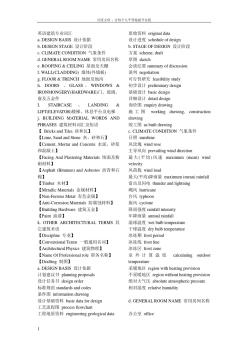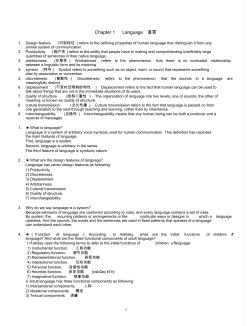Contents
Chapter 1 Introduction 1
§1.1 DEFINITION OF GEOMATICS 1
§1.2 BRANCHES OF GEOMATICS 3
§1.3 HISTORY AND DEVELOPMENT OF GEOMATICS 6
Problems and Exercises 8
Chapter 2 Basic Concepts of Surveying 9
§2.1 THE EARTH, GEOID AND ELLIPSOID 9
2.1.1 The Shape and Size of the Earth 9
2.1.2 Geoid and Ellipsoid 10
2.1.3 Reference Ellipsoids 11
§2.2 POSITIONING OF POINTS ON THE GROUND 12
2.2.1 Independent Planar Coordinate Systems 12
2.2.2 Geographic Coordinate Systems 13
2.2.3 Gauss-Kruger Planar Coordinate System 15
§2.3 RECTANGULAR COORDINATES 17
2.3.1 Reference Directions 18
2.3.2 Azimuths and Bearings 19
2.3.3 Principle of Coordinates Computation 22
§2.4 INTRODUCTION TO MAPS 24
2.4.1 Maps 24
2.4.2 Map Scales 26
2.4.3 Contours 28
Problems and Exercises 32
Chapter 3 Leveling 35
§3-1 GENERAL BACKGROUND 35
3.1.1 Leveling Terms 35
3.1.2 Vertical Datum of China 37
3.1.3 Principles of Direct Leveling 38
§3.2 CURVATURE AND REFRACTION 39
3.2.1 Effect from the Earth’s Curvature 39
3.2.2 Effect from the Atmospheric Refraction 39
§3.3 LEVELING METHODS 40
3.3.1 Vertical Distances Measuring 41
3.3.2 Direct Leveling 41
3.3.3 Barometric Leveling 42
3.3.4 Trigonometric Leveling 42
§3.4 EQUIPMENT FOR DIRECT LEVELING 46
3.4.1 Telescopes 46
3.4.2 Level Vials 48
3.4.3 Tilting Levels 50
3.4.4 Automatic Levels 50
3.4.5 Electronic Digital Levels 51
3.4.6 Hand Level 53
3.4.7 Leveling Tripods and Rods 54
§3.5 FIELD AND OFFICE WORK FOR LEVELING 55
3.5.1 Operation for Leveling 55
3.5.2 Differential Leveling 57
3.5.3 Office Work in Leveling 62
§3.6 LEVEL TESTING AND ADJUSTING 65
3.6.1 Requirements for Level Testing and Adjusting 65
3.6.2 Parallax Adjusting 66
3.6.3 Circular Level Testing and Adjusting 67
3.6.4 Preliminary Adjustment of the Horizontal Cross Hair 68
3.6.5 Sightline Testing and Adjusting (Angle i Testing) 68
§3.7 SOURCES OF ERROR IN DIRECT LEVELING 70
3.7.1 Instrumental Errors 70
3.7.2 Personal Errors 71
3.7.3 Natural Errors 73
3.7.4 Mistakes 75
3.7.5 Errors Reducing and Mistakes Eliminating 76
Problems and Exercises 76
Chapter 4 Angles Measurement 83
§4.1 GENARAL BACKGROUND 83
4.1.1 Reference Directions for Vertical Angles 83
4.1.2 Meridians 84
4.1.3 Horizontal Angles 85
4.1.4 Azimuths 85
4.1.5 Bearings 85
4.1.6 Reverse Azimuth 86
4.1.7 Azimuth Calculations 86
§4.2 THEODOLITES 87
4.2.1 Classification of Theodolites 87
4.2.2 Geometrical Principle of Optical Theodolite 88
4.2.3 Optical Theodolite Components 89
4.2.4 Reading Devices and Methods 90
§4.3 MEASUREMENT OF HORIZONTAL ANGLES 92
4.3.1 Theodolite Setup 92
4.3.2 Object Sighting and Aiming Marks 93
4.3.3 Horizontal Angle Measurement 94
4.3.4 Station Computations 96
§4.4 MEASUREMENT OF VERTICAL ANGLES 98
4.4.1 The Uses of Vertical Angle 98
4.4.2 Structure of Vertical Circle 99
4.4.3 Vertical Angles 99
4.4.4 Zenith Angles 100
4.4.5 Index Error of Vertical Circle 101
§4.5 THEODOLITE TESTING AND ADJUSTING 103
4.5.1 Plate Bubble Axis Perpendicular to Vertical Axis 104
4.5.2 Vertical Cross-Hair Perpendicular to Horizontal Axis 104
4.5.3 Optical Axis Perpendicular to Horizontal Axis 105
4.5.4 Horizontal Cross-hairs Lies on the Sight Axis 106
4.5.5 Circular Level 106
4.5.6 Optical Plummet 107
§4.6 ELECTRONIC THEODOLITES 107
4.6.1 Configuration of Electronic Theodolite 107
4.6.2 Use of Electronic Theodolite 109
Problems and Exercises 109
Chapter 5 Distance Measurement 113
§5.1 METHODS OF DISTANCE DETERMINATION 113
5.1.1 Pacing 113
5.1.2 Odometer 114
5.1.3 Tachometry 114
5.1.4 Subtense Bar 115
5.1.5 Taping 115
5.1.6 EDM (Electronic Distance Measurement) 116
§5.2 DISTANCE MEASUREMENT BY STEEL TAPING 116
5.2.1 Taping Equipment and Accessories 117
5.2.2 Maintenance of Tapes and Other Accessories 119
5.2.3 Taping on Level Ground 119
5.2.4 Horizontal Measurements on Sloping Ground 121
5.2.5 Slope Measurements 122
§5.3 TAPES VERIFYING AND ERRORS IN TAPING 123
5.3.1 Length Correct 123
5.3.2 Temperature Correct 124
5.3.3 Tension Inconsistent 124
5.3.4 Tape Sag 125
5.3.5 Tape Sloping 125
5.3.6 Tape off Line 126
5.3.7 Improper Plumbing 126
5.3.8 Faulty Marking 126
5.3.9 Incorrect Reading or Interpolation 126
5.3.10 Equation of Taping Length and Tape Verifying 126
§5.4 PRINCIPLES & METHOD OF STADIA RANGING 129
5.4.1 Concept for Stadia 129
5.4.2 Principle and Formulas of Stadia Measurement 129
§5.5 ELECTRONIC DISTANCE MEASUREMENTS 132
5.5.1 General Background 132
5.5.2 Principle of EDM 133
5.5.3 Measurements with EDM instruments 135
5.5.4 Errors Sources in EDM 136
5.5.5 Reductions 137
§5.6 TOTAL STATIONS 137
5.6.1 General background to Total Station Instruments 137
5.6.2 Survey System with Total Stations 138
5.6.3 General Survey Methods 139
5.6.4 Using Total Stations 140
5.6.5 Miscellaneous Useful Screens, Commands, and Keys 142
Problems and Exercises 143
Chapter 6 Theory of Errors and Survey Adjustment 145
§6.1 INTRODUCTION TO SURVEY ERRORS 145
6.1.1 Measurement Errors 145
6.1.2 Sources of Errors in Observation 147
6.1.3 Classifications of Errors 147
6.1.4 Some Definitions 148
6.1.5 Eliminating Mistakes and Systematic Errors 149
6.1.6 Probability 150
6.1.7 The Most Probable Value 150
6.1.8 Residuals/Corrections 151
§6.2 CHARACTERISTICS OF RANDOM ERRORS 152
6.2.1 Occurrence of Random Error 152
6.2.2 General Laws of Probability 153
§6.3 MEASURES OF PRECISION 155
6.3.1 Mean Square Error 155
6.3.2 Relative Errors 157
6.3.3 Allowable Error 158
§6.4 LAW OF ERROR PROPAGATION 158
6.4.1 Error of a Sum 159
6.4.2 Error of a Series 159
6.4.3 Error in a Product 160
6.4.4 Error of the Mean 161
§6.5 DIRECT ADJUSTMENT FOR EQUAL-PRECISION OBSERVATIONS 162
6.5.1 Background of Survey Adjustment 162
6.5.2 Least Squares Method 163
6.5.3 Arithmetic Mean 165
6.5.4 Estimation of Precisions of Arithmetic Mean 165
§6.6 DIRECT ADJUSTMENT FOR UNEQUAL-PRECISION OBSERVATIONS 168
6.6.1 Conditional Adjustment of Observation 168
6.6.2 Weight of Observation 168
6.6.3 Least Squares Adjustment 169
6.6.4 Weighted Arithmetic Mean 170
6.6.5 Functions of Weight 171
6.6.6 Unit Weight 172
6.6.7 Weight Computations 172
6.6.8 Law of Weight Reciprocal Propagation 174
6.6.9 Precision Estimation 175
Problems and Exercises 179
Chapter 7 Control Survey for Small Areas 185
§7.1 INTRODUCTION TO CONTROL SURVEY 185
7.1.1 Plane Control Survey 185
7.1.2 Vertical Control Survey 187
7.1.3 Control Survey over Minor Area 188
§7.2 FIELD WORK IN TRAVERSING 189
7.2.1 Classification of Traverses 189
7.2.2 Field Work in Traversing 191
7.2.3 Method of Tree-tripods 192
§7.3 OFFICE WORK IN TRAVERSING 193
7.3.1 Departure and Latitude from Planar Coordinates 194
7.3.2 Checking and Reducing Angles and Distances 195
7.3.3 Adjusting"para" label-module="para">
7.3.4 Adjusting"para" label-module="para">
§7.4 TRIANGULATION 201
7.4.1 Survey Methods Using Triangles 201
7.4.2 Patterns of Triangulation 202
7.4.3 Tasks of Triangulation 203
7.4.4 Survey Procedures 203
7.4.5 Triangulation Computations 204
§7.5 INTERSECTION 205
7.5.1 Patterns of Intersection 206
7.5.2 Intersection Computations 207
§7.6 INTRODUCTION TO GLOBAL POSITIONING SYSTEM 208
7.6.1 Principles of GPS 209
7.6.2 The Configuration of GPS Satellite System 209
7.6.3 Methods 210
7.6.4 Positioning Techniques 212
7.6.5 Sources of GPS Signal Errors 214
7.6.6 Smart-Stations 215
Problems and Exercises 216
Chapter 8 Topographical Mapping with Large Scales 219
§8.1 INTRODUCTION TO MAP MAKING 219
8.1.1 Topographic Maps 219
8.1.2 Methods for Topographical Surveying 220
8.1.3 Mapping Control Surveys 220
8.1.4 Requirements for Topographic Survey 221
§8.2 FEATURES DRAWING ON MAPS 223
8.2.1 Topographic Maps and Thematic Maps 223
8.2.2 Topographic Drawing 223
8.2.3 Map Symbology 224
8.2.4 Plans 225
§8.3 FIELD WORK OF MAPPING 225
8.3.1 Location of Contours 225
8.3.2 Methods of Obtaining Topography 226
8.3.3 Specifications and Error Analysis in Topographic Surveys 227
§8.4 GRAPHIC MAPPING USING PLANE-TABLE 228
8.4.1 Introduction to Graphic Mapping 228
8.4.2 Plane-table 229
8.4.3 Setup a Plane-table 230
8.4.4 Locating Details by a Plane-table 230
§8.5 DIGITAL MAPPING USING TOTAL STATIONS 231
8.5.1 Introduction 231
8.5.2 Procedures on a Station 233
8.5.3 Setting-Up a Backsight 233
8.5.4 Azimuth Mark 234
8.5.5 Measurement 234
8.5.6 Radial Shooting 235
8.5.7 Outcrop Mapping 236
8.5.8 Traverse 236
8.5.9 Data Retrieval and Arrangement 237
Problems and Exercises 238
Chapter 9 Application of Topographic Maps 239
§9.1 GENERAL APPLICATIONS 239
9.1.1 Determining the Elevation of a Point 239
9.1.2 Determining the Rectangular Coordinates of any Point 240
9.1.3 Determining the Azimuth and the Horizontal Distance of a Line Segment 241
§9.2 AREA MEASUREMENT ON TOPOGRAPHIC MAPS 242
9.2.1 Area Measured by Planimeter 242
9.2.2 Area Measured by Coordinates 244
9.2.3 Area Measured by Irregular Figures 245
§9.3 APPLICATION OF MAPS IN CONSRUCTION 247
9.3.1 Topographic Profiles 247
9.3.2 Determining the Catchment Area 248
9.3.3 Determining the Shortcut Path According to a Specific Gradient 248
9.3.4 Volumes from Contour Lines 249
Problems and Exercises 251
Appendix A 《测绘学基础》知识要点与习题答案 253
Appendix B Vocabulary in Geomatics 295
References 303

 常用英语建筑学专业词汇
常用英语建筑学专业词汇

 英语语言学概论--整理
英语语言学概论--整理